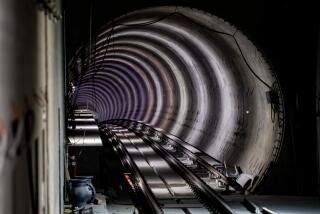Metro urged to add a Leimert Park stop on the Crenshaw Line
- Share via
Leimert Park Village has long been a soul of African American life and culture in South Los Angeles.
Jazz and blues regularly spill into the street, and shoppers browse the titles at one of the last remaining black-centric bookstores. Community activists meet in Leimert Park Village and residents sometimes hold memorial vigils there.
But to dismay of some in South L.A., a new light rail line set to run through the heart of L.A.’s black community does not include a stop at the historic district. Instead, planners want to build a station about half a mile north, at the Crenshaw-Baldwin Hills mall, which they believe is more of a draw.
Construction of the Crenshaw Line is expected to begin next year, but some community leaders and residents are making a last-ditch effort to secure a stop in Leimert Park. They argue it’s the right thing for the community and would make Leimert Park Village even more of a cultural draw.
“Leimert is its own special place. You cannot have a station at [Martin Luther King Jr. Boulevard] and a station at Slauson [Avenue] and not have one at Leimert,” said attorney Nana Gyamfi, who lives in South L.A. and likes to hang out and shop in the village. “That doesn’t even make sense to anyone that knows anything about the area.”
But Metropolitan Transportation Authority officials are dubious, saying the station would add about $148 million to the $1.7-billion project and serve only about 840 riders a day. The Crenshaw Line is already $80 million over budget.
Roderick Diaz, the project director for the Crenshaw Line, said adding a stop would also violate a longtime Metro practice of not having stations less than a mile apart. (The rule has been broken before, as on the Expo Line near USC and on the Purple Line near Wilshire Center.)
The “cost increases create friction because it could cut into what others have available for their projects around the county,” added David Yale, Metro’s deputy executive officer for countywide regional planning and development. “We’re stretched in two different directions, both on costs and on revenues.... This is a hard decision for the board to make.”
The debate comes at what should be a upbeat moment for the denizens along Crenshaw Boulevard, who have been pushing for years for a piece of L.A.’s light rail system.
The 8.5-mile line would run from the Expo Line at Exposition Boulevard south along Crenshaw Boulevard through Inglewood, terminating at the Green Line near Los Angeles International Airport.
When Leimert Park was developed in the late 1920s, it was restricted to whites and was known for its lush golf courses. But black musicians, writers and artists began moving into the area after the 1965 Watts riots.
Now Leimert Park Village is host to community festivals celebrating Kwanzaa and Martin Luther King Jr. Day, and its cultural significance was bolstered earlier this year when the nonprofit Barbara Morrison Performing Arts Center opened there.
Storeowners in Leimert Park Village have fallen on hard times in recent years, and foot-traffic has dwindled. A Starbucks at Crenshaw and Vernon boulevards closed, as did other shops.
Shop owners and some community planners said they hoped a transit stop at Leimert Park Village would help revitalize business.
“If you had a stop there, it becomes that much more attractive for a national retailer. It becomes that much more of a destination, not just for the African American community but for the city at large,” said community development activist Tunua Thrash. “A transit stop there is positioning us for a future in Leimert Park.”
L.A. County Supervisor Mark Ridley-Thomas has asked the Metro board to add the Leimert stop and spend $269 million more to put the rail line underground for a roughly one-mile section at Park Mesa Heights.
The supervisor has proposed shifting funds away from other projects, including a portion of the $200 million that is to be allocated for a possible extension of the Crenshaw and Green lines toward LAX.
“Leimert Park Village is probably the most appropriate place to have a station on the entire Crenshaw Corridor, Ridley-Thomas wrote in a letter to Art Leahy, Metro’s chief executive. “Omitting a station at this location would be like building the Red Line without a stop in Hollywood … or the Gold Line without Mariachi Plaza.”
Officials hope to have the Crenshaw Line open by 2018. Metro predicts between 12,000 and 20,000 riders each weekday.
More to Read
Sign up for Essential California
The most important California stories and recommendations in your inbox every morning.
You may occasionally receive promotional content from the Los Angeles Times.













